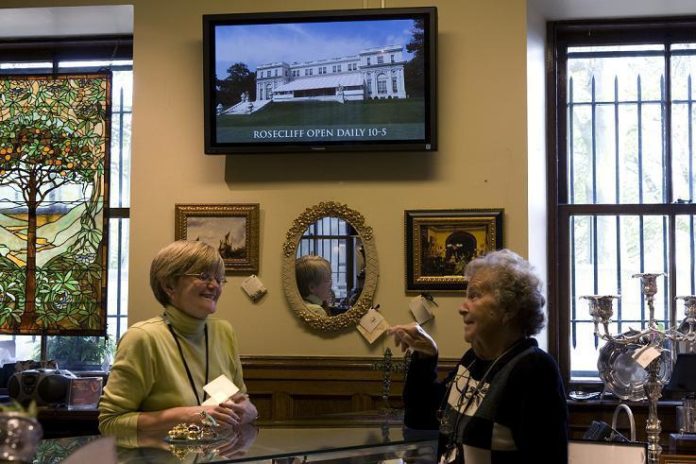
Visitors to the Newport Mansions don’t just get to browse through souvenirs and books about the city and the properties they are visiting. On high-definition TV screens in the stores, they also can see pictures from other mansions, get tour schedules and more.
John Rodman, director of sales and marketing for the Preservation Society of Newport County, which manages the 11 historic properties, said the system, known as “digital signage,” has worked well for the stores. He’s gotten nothing but positive feedback.
Before, the society had shown videos of the mansions on TV screens, but viewership of those videos “had been declining for a long time,” he said. “So we were looking for an alternative.”
Digital signage systems can display PowerPoint presentations, slideshows, videos and other types of materials. The Preservation Society, for example, uses a mix of still images, ads, promotional information and videos of less than 90 seconds each.
The idea behind digital signage is that static content – the stuff of old-fashioned signs – is just not good enough for today’s consumer. Thus a good digital sign offers a mix of content, changed as frequently as needed to stay fresh and up to date.
Digital signs were first used in Las Vegas, and then became commonplace in airport terminals, large chain stores and hotels. Now, with the cost of LCD and plasma screens down substantially, they are being adopted more and more by small businesses as well.
Charles Ball, president of Middletown’s BMI Technologies, which installs LCD and plasma signage, noted that a 42-inch LCD screen costs about $1,300 to $1,800 now, down from $5,000 a few years ago. “Now, for under $2,500, you can get yourself into the ball game,” he said.
And setups smaller than 42 inches – wired and designed by BMI – cost about half that, he said.
“Youcan do it for a lot less if you want a smaller screen. Let’s say you’re a women’s fashion store and you just want to show the specials of the day; you can get away with a 19- or 20-inch screen. Those things you can buy for $300 or $400.”
That’s why, for BMI Technologies, sales have jumped in the past two years.
In-store advertisements and signs can draw customers to what they are already there for, making digital signage a flashy, useful link between customers and what they need, said Brian Heil, president of the American Marketing Association Southeastern New England Chapter.
“Anything where you can help direct or enhance the experience within your environment through signage, as long as it is not too intrusive, helps people find what they want quicker,” he said.
GYN-OB Associates Inc., in Fall River, uses the screens for more than promotion. During the day, the screen that BMI installed in the waiting room acts as a TV, but “in the evening, the nurses gave courses to the clients about taking care of the baby,” said BMI’s Ball. “And they were running shows that they had created on their computer.”
Ball said some retailers initially question why they can’t just use a regular TV, which might cost less than an LCD screen. But most TVs couldn’t correctly handle digital media.
“The screen that has the capability to receive a signal to play a signal from a computer is slightly different than the one that is a TV,” Ball said. But many LCD screens have the ability to do both; the advertisement can be either media from a computer or DVD player. “You can buy yourself a TV, but it may or may not have a connection to a computer.”
And the advertising that’s on the screens will only grow in inventiveness, Ball said. For most of his installations, he designs an original ad and then the company usually steps in to designs its own – which many are finding to be a liberating form of advertising.
“Really, the creativity is just starting to come out of it,” Ball said. •











